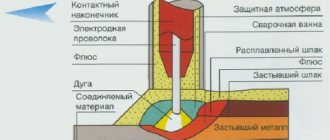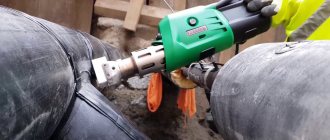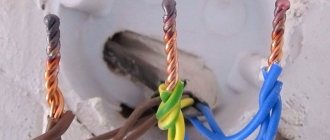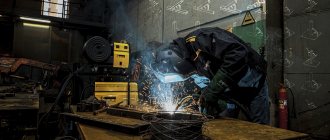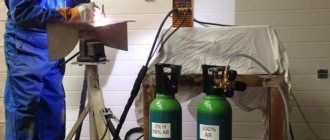Home / Welding technique
Back
Reading time: 3 min
0
2005
One type of welding work is pipe welding. In his career, perhaps every welder has encountered this. Pipe welding has its own dangers and difficult aspects of work.
Novice specialists, aware of the complexity of pipe welding, refuse to work with such parts. There are few specialists with serious experience in this matter.
However, if you study this type of welding, it becomes clear that it is not difficult to perform. It is important to weld the root of the seam correctly. Transmission welding will help with this.
- Introduction
- Stages of work when welding through transmission
- Selection of RDS
- Pipe welding stage
- Errors in welded pipe processing
- Conclusion
Introduction
This article talks about what transmission welding is, how to properly join pipe elements, what equipment settings are needed, and how to reliably fill a seam.
By studying the data provided, you can understand how transmission welding of pipes occurs and how to achieve seam quality with this type of welding.
By welding “through” or “through” the root of the seam, the welder welds pipes with a gap between the parts. This gap must be through, that is, have a gap.
This technology is suitable for pipes up to twelve millimeters in diameter. However, in rare cases, large-sized pipes are also processed. Parts that are ready for processing are called “coil”.
The term "through" is also used for connecting pipes subject to radiographic inspection. During this test, rays are directed at the metal, which “transparent” it.
Stages of work when welding through transmission
Preparation for machining the part plays an important role in creating a reliable connection. This type of welding is no exception.
However, if a novice welder is performing transmission welding, a couple of training passes should be carried out. To do this, unnecessary parts are taken that can be damaged. Medium-sized pipes with walls 5-10 mm are suitable.
The preparatory stage always begins with cleaning the surface of the part. Whether it is welded for training or for subsequent use, the seam area must be cleaned of dirt, traces of paint, and rust.
Using a suitable tool (sandpaper, files, grinder, metal brushes), irregularities and burrs are removed.
At the end of preparation, the surface of the part should have a characteristic metallic sheen. After cleaning, the metal is degreased. For this purpose, you cannot use highly flammable substances (gasoline, kerosene and their derivatives).
After preparation, the parts are joined. Their weight can be high. And it is difficult to make an exact connection. Therefore, at this stage additional mechanisms (centralizers) are used. There are budget, small-sized models.
They are easy to install and use in everyday life. A small distance is left between the parts. It should not exceed the dimensions of the filler rod. On the contrary, the diameter of the rod should be slightly larger than the gap left.
The recommended distance between parts is 2.5 mm.
Having finished preparing the pipes, you need to move on to preparing the filler rods. Leaving a gap of two and a half millimeters between the pipes, the rod is taken with a size of 2.6 mm.
Electrodes of this diameter are produced by different manufacturers, among them Kobelco model LB52U.
If the rods have been stored for a long time without use, they need to be dried before use. To do this, they are placed in the oven for one and a half to two hours. The drying temperature should not exceed 380°C. Drying is carried out before the welding process.
If it is not possible to calcinate the electrodes, you need to ensure they are dry during storage. To do this, they need to be placed in a pencil case for rods. You can make such a pencil case yourself or purchase it.
The coating of the electrodes absorbs moisture from the environment well, so maintaining dryness is an important point. A wet coating may be damaged during welding, which will impair performance.
Selecting mode parameters
The welding current is selected: for single-pass welding - depending on the thickness of the pipe wall, and for multi-pass welding - based on the height of the bead, which should be 2 - 2.5 mm. Welding current is prescribed at the rate of 30 - 35 A per 1 mm of electrode diameter.
The arc voltage should be minimal, which corresponds to short arc welding.
The welding speed is adjusted as follows. to ensure the penetration of the edges and the formation of the required dimensions of the seam.
The consumption of shielding gas depends on the grade of steel being welded and the current mode (from 8 to 14 l/min).
Filler wire with a diameter of 1.6-2 mm is selected according to the grade of steel being welded (see article Welding materials).
Approximate modes
| The seam | Diameter of W-electrode, mm | Additive diameter, mm | Welding current, A | Arc voltage, V | Gas consumption, l/min |
| Root | 2-3 | 1,6-2 | 70-110 | 12-16 | 6-8 |
| Filling | 3-4 | 2-2,5 | 80-130 | 14-18 | 8-12 |
Minimum current modes depending on the brand of W-electrode
| Diameter of W-electrode, mm | Direct current (A) polarity | Alternating current, A | |||||||
| Straight | Reverse | ||||||||
| EVL | EVI | EVT | EVL | EHF | EVT | EHF | EVL | EVI | |
| 2 | 80 | 180 | 120 | 20 | 25 | 25 | — | — | — |
| 3 | 230 | 380 | 300 | 35 | 50 | 30 | — | — | 180 |
| 4 | 500 | 620 | 590 | 60 | 70 | 60 | 180 | 170 | 220 |
| 5 | 720 | 920 | 810 | — | — | 70 | — | 210 | 270 |
| 6 | 900 | 1500 | 1000 | 100 | 120 | 110 | 250 | 250 | 340 |
Welding begins immediately after installing the tacks, which must be remelted when performing the first layer. In hard-to-reach places, the first root weld can be made without filler wire if the gap and edge mixing do not exceed 0.5 mm, and the blunting of the edges does not exceed 1 mm. The exception is the joints of pipes made of steels 10 and 20, which always need to be welded with an additive.
The order of applying layers when welding a fixed joint by one welder
The arc should be ignited and extinguished at the edge of the pipe or at an already applied seam at a distance of 20-25 mm from the end of the seam. The supply of argon is stopped 5-8 s after the arc breaks.
Welding of pipelines made of high-alloy, especially corrosion-resistant, steels is carried out with protection of the weld root either by supplying argon inside the pipe, or using FP8-2 flux paste.
When welding high-alloy steels, a number of conditions must be observed:
- minimum current modes;
- short welding arc;
- maximum welding speed without interruptions and reheating of the same section of metal;
- avoid lateral vibrations of the burner;
- the filler wire should be fed evenly so as not to create splashes of molten metal, which, once on the base metal, can subsequently cause corrosion.
On thick-walled (more than 10 mm) pipelines with a diameter of more than 100 mm made of low-carbon and low-alloy steels, the root seam is welded using the argon arc method without remaining backing rings.
Welding should be carried out in a reverse-step manner in sections no longer than 200 mm. The height of the root seam must be at least 3 mm. In this case, it is necessary to ensure smooth transitions to the surface of the pipe.
Direction and sequence of laying the root layer
Argon arc welding is also used when welding the backing ring in pipes made of carbon and low-alloy steels. The ring is installed tightly, but without tension, in the pipe, leaving a gap between the ring and the inner surface of the pipe of no more than 1 mm. The ring is secured from the outside with a fillet weld 15-20 mm long with a leg of 2.5-3 mm to pipes with a diameter of up to 200 mm in two places, and with a larger diameter in three or four places.
Tack welding, regardless of the steel grade of the pipe and backing ring, is performed with Sv-08G2S filler wire with a diameter of 1.6-2 mm. The backing ring is welded with a single-layer fillet weld with a leg of 3-4 mm with the same additive.
Tacking and welding of the backing ring is done without preheating, regardless of the steel grade and pipe wall thickness. The exception is pipes made of steel 15Х1М1Ф with a wall thickness of more than 10 mm - the end of such a pipe is heated to 250 - 300 ° C.
Selection of RDS
Setting the welding mode is the basis for high-quality joining of parts. Transmission welding is no exception. There are different types of welding joints suitable for different types of welding work.
When processing pipes, when choosing a welding mode, the thickness of the pipe wall and the filler rods used are important. The current strength is selected for each type of part separately. Experience or advice from a colleague will help with this.
Regarding other points of the welding regime:
- A short welding arc length is used.
- The welding speed is set to average. An increased speed is fraught with skips, a reduced one – with burns in the seam fabric.
- The polarity is set to negative.
- Type of current – constant.
The power of the arc voltage plays an important role in the welding mode. However, it and several other indicators are selected in accordance with a specific part. Many characteristics of welding work depend on the preferences of the craftsman.
The key point in transmission welding is the correct technological window. It is a depression formed during the melting of the edges of the pipe joint.
You need to carefully monitor it, since with its help you can notice in time that the quality of the seam is compromised.
Flash welding a root weld requires a lot of practice. The selection of the correct welding mode occurs experimentally, which means that the more pipe welding is carried out, the easier it will be to determine the settings for a specific part.
At the stage when there is no experience yet, you can ask recommendations from older generation masters.
Start setting up the welding machine
After hardening the electrodes, it is necessary to adjust the current strength for operation. It depends on the size of the walls of the pipes being welded. In this case, it is necessary to select the current strength so that the electrodes are not filled with slag or metal when working at the top.
Basic settings of a semi-automatic welding machine.
In this case, it is worth paying attention to the fact that in the event of a change in polarity (when the electrode becomes “+” and the pipe “-”), the molten metal will flow in the direction of the welding object. It is important to note that this process only exists when welding with direct current. Next, the electrode is ignited and the edges are melted (this process is usually called cutting), as a result of which jumpers appear between them. Then you need to form a short arc and lightly touch the chamfers. In this case, the touches must be the same for both sides. During the welding process, metal molecules from the electrode move towards the object, and then, “hanging” over the jumpers, form an internal bead. In the future, you should move forward without moving the electrodes towards you, i.e. without increasing the gaps. In this case, the electrode should be perpendicular to the surface of the object and slightly inclined relative to the axis of the object.
If the electrode is incorrectly selected, it is possible that the object will not have time to cool down and the weld seam will sag from welding, forming a sag. If a mistake is made and the electrode is pulled away from the pipe, the metal may fail. Therefore, it is necessary to constantly monitor the technological window. It is the presence of this hole that indicates the correctness of the process and the presence of penetration. In this case, the hole (technological window) should have a relatively stable small size, about 3 mm. If the window has a larger diameter, this will lead to the formation of sagging.
After welding the root, the surface is cleaned.
Pipe welding stage
After the surface preparation has been carried out and the welding force has been selected, the transmission welding process can begin. At the beginning of creating a joint, several tack points are formed.
These elements will protect the root of the seam from deformation during operation. The number of tacks is created depending on the diameter of the pipes. Larger diameters require more tacks.
The number of points should be enough to hold the parts together. This fastening must be reliable, so you need to weld the potholders in the same way as welding the seam.
After all points are created, the joint is cleaned. This is done to identify root defects. At this stage, they can still be removed and remade. If the root has defects during subsequent processing, the part will be damaged.
After creating a reliable seam, uniform filling of the joint begins. When welding a pipe through the gap, this is a simple step.
During normal stripping, the root is melted at a level of thirty percent. A good degree of stripping will reduce root melting.
If during welding it is necessary to change the filler rod, then you need to continue working slightly below the stopping point. This will give the connection accuracy and protect against defects.
Welding steel pipes “through transmission” - step-by-step instructions
Pipes with thick walls, in which 2 mm is only the amount of dullness, are welded “through the light”.
Preparation and cutting of edges
The abrasive method is the least reliable due to the introduction of abrasive particles into the metal, which interferes with high-quality melting and leads to the appearance of cracks.
- Use a double-sided Y-shaped symmetrical groove with an angle of 65 degrees, an optimal amount of bluntness and a gap of 2 mm.
- When preparing bevel edges, use thermal or mechanical methods. Due to the high cost of thermal cutting (laser, plasma), various types of mechanical processing are used in practice, which make it possible to obtain a plane with high accuracy:
- processing on a milling machine;
- manual bevel processing;
- cutting using abrasive wheels;
- processing with slotting-type edge cutters.
- Clean the joints of the welded products to white metal. There should be no irregularities, burrs or rust left.
- Treat surfaces with acetone or any similar substance. The presence of grease, dirt, and dust prevents the high-quality connection of metal molecules.
Centering and joining of pipes
- Centering and joining of small-diameter products is carried out by fixing them using improvised means or using assistants.
- Center large pipes (from 60 mm) with special equipment - a centralizer: internal or external. Both have an electro-hydraulic drive. Internal ones are more preferable due to the fact that when they are used, the joint remains uncovered. This allows the use of automatic welding machines, and also does not limit manipulations during manual connection.
- Do not allow deviations when using the manual alignment method. It is impossible to dock perfectly without a centralizer, but try to minimize the deviation.
- Having connected the pipes exactly, proceed to welding the root seam.
Root welding
- Cook the seam under the following conditions:
- minimum current;
- reverse polarity;
- short electric arc;
- dry electrodes;
- lack of wind in the pipe.
- Cook vertically, the electrode is perpendicular to the plane.
- Use an electrode to melt the edges - a bridge will appear between them, which is called a weld pool. In front of the jumper there is a so-called technological window.
- Carefully monitor the size of the technological window: throughout the entire process it should remain the same diameter.
- Make a root seam no more than 1 mm high. The return roller should also not exceed this value.>
- Clean the beginning and end of the seam and the transition area between the electrodes to avoid the formation of pores in the metal, the presence of which will sooner or later lead to loss of the pipe’s tightness.
Filling and capping of the weld
- After welding the root, fill the entire seam section.
- Depending on the wall thickness and material, use a single-layer or multi-layer penetration method.
- The movement of the electrode during filling is a triangle: edge 1 - edge 2 - technological window.
- Pay attention to the heating of the edges and root seam. The greater the heating, the wider the filling step.
- After each layer, clean the surface of slag.
- If you have the skill, and if the wall diameter allows, fill and cover in one pass.
Video lesson on welding pipes under clearance
Errors in welded pipe processing
Since in practice, penetration welding of pipes is a difficult job, novice welders often reject parts. It is impossible to get rid of it without practice and personal experience.
An analysis of the theory of welding and standards for transmission welding can speed up learning.
The following will describe errors in pipe clearing and ways to prevent them.
The first problem is the uncooked areas. They appear when the welding speed is exceeded and the welder is not experienced enough. Lack of practice plays a key role in transmission welding.
And it is the accumulation of experience that will prevent the occurrence of incomplete welding in the future.
Often the part is spoiled by the presence of sagging areas created by sloppy seams. This is the result of non-compliance with the technological process and transmission welding mode.
Experience and intuition are important in penetration welding, but studying the technical documentation for the task will greatly facilitate the work.
A couple more tips to prevent common mistakes:
- Despite the complexity, welding is performed with a short welding arc length. Even if you want to make the task easier, you cannot change the length of the arc. Welding already at a medium value will deteriorate the quality of the connection.
- During the welding process, the rod does not come off. The filler rod is torn off only when it is necessary to update it.
- From part to part you need to monitor the current settings.
- The preparatory stage should not be ignored. Proper stripping and trimming of edges makes the job easier.
- The work is carried out only with dry filler rods.
- You should not carry out the welding process in the light during bad weather.
- The quality of equipment and additional elements also plays a role in the reliability of the result.
Areas of application of argon-arc welding
Argon welding of pipes and other metal workpieces is used in various industries, as well as in domestic conditions and in small industries. Basically, the technology is used for joining parts made of non-ferrous metals and alloy steels. If you have to work with products of small thickness, then welding is performed without the use of additives.
Using shielded gas welding technology, they extend the life of automobile parts, cut threads, and patch cracks. To obtain a high-quality weld, the welder requires experience, as well as knowledge in the field of physical and chemical properties of various metals.
The technology of argon welding of pipes and other metal products makes it possible to obtain a high-quality seam and maintain the same depth of metal penetration. It is used when it is necessary to connect non-rotating pipe joints. To work with workpieces made of aluminum and titanium alloys, non-consumable electrodes are required, for products made of aluminum and stainless steel - consumable ones.




